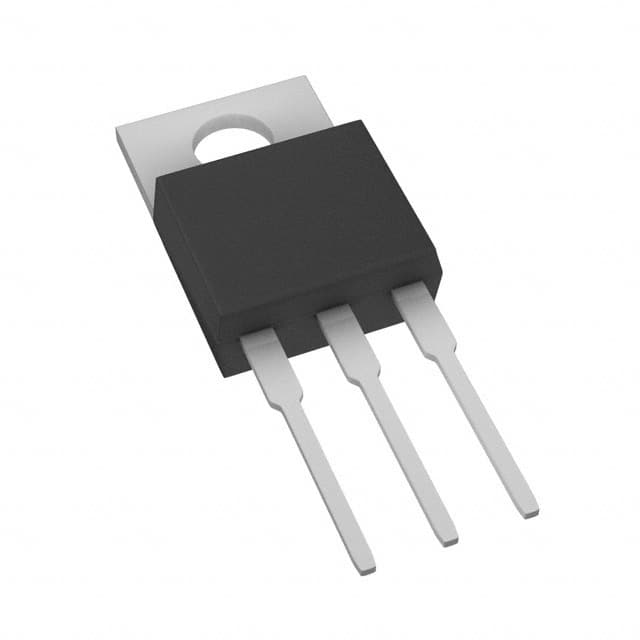MBR3035CT-E3/45
Introduction
The MBR3035CT-E3/45 is a diode belonging to the category of Schottky rectifier diodes. This entry provides an overview of the basic information, specifications, detailed pin configuration, functional features, advantages and disadvantages, working principles, detailed application field plans, and alternative models of the MBR3035CT-E3/45.
Basic Information Overview
- Category: Schottky Rectifier Diode
- Use: The MBR3035CT-E3/45 is commonly used in power supply applications, voltage clamping, reverse polarity protection, and freewheeling diodes.
- Characteristics: It exhibits low forward voltage drop, high switching speed, and low leakage current.
- Package: The diode is typically available in a TO-220AB package.
- Essence: The MBR3035CT-E3/45 is essential for efficient power conversion and voltage regulation.
- Packaging/Quantity: It is usually packaged in reels or tubes with varying quantities based on manufacturer specifications.
Specifications
- Voltage Rating: 35V
- Current Rating: 30A
- Forward Voltage Drop: Typically 0.55V at 15A
- Reverse Leakage Current: Typically 100µA at 35V
- Operating Temperature Range: -65°C to +175°C
Detailed Pin Configuration
The MBR3035CT-E3/45 typically has three pins: 1. Anode (A) 2. Cathode (K) 3. Heatsink or Tab (H)
Functional Features
- Low Forward Voltage Drop: Enables efficient power conversion and reduced power dissipation.
- High Switching Speed: Facilitates rapid switching in power supply and voltage regulation applications.
- Low Leakage Current: Ensures minimal power loss during reverse bias conditions.
Advantages and Disadvantages
Advantages
- Efficient power conversion
- Fast switching speed
- Low power dissipation
Disadvantages
- Limited voltage and current ratings compared to some other diode types
- Sensitivity to temperature variations
Working Principles
The MBR3035CT-E3/45 operates based on the Schottky barrier principle, where the metal-semiconductor junction allows for faster switching and lower forward voltage drop compared to conventional PN-junction diodes. When forward biased, it allows current flow with minimal voltage drop, making it suitable for high-frequency applications.
Detailed Application Field Plans
The MBR3035CT-E3/45 finds extensive use in various applications including: - Power supplies - Voltage clamping circuits - Reverse polarity protection - Freewheeling diodes in inductive load circuits
Detailed and Complete Alternative Models
Some alternative models to the MBR3035CT-E3/45 include: - MBR3045CT-E3/45: Higher voltage rating (45V) with similar current and package specifications. - MBR3060CT-E3/45: Higher voltage and current rating (60V, 30A) with similar package specifications.
In conclusion, the MBR3035CT-E3/45 is a versatile Schottky rectifier diode with efficient power conversion capabilities, fast switching speed, and low power dissipation. Its applications span across various industries, making it a crucial component in power supply and voltage regulation circuits.
Word Count: 464
قم بإدراج 10 أسئلة وإجابات شائعة تتعلق بتطبيق MBR3035CT-E3/45 في الحلول التقنية
What is the MBR3035CT-E3/45?
- The MBR3035CT-E3/45 is a Schottky diode rectifier designed for high efficiency and low power loss in applications such as switch mode power supplies, free-wheeling diodes, and reverse battery protection.
What is the maximum forward voltage drop of the MBR3035CT-E3/45?
- The maximum forward voltage drop of the MBR3035CT-E3/45 is typically around 0.55V at a forward current of 30A.
What is the reverse voltage rating of the MBR3035CT-E3/45?
- The MBR3035CT-E3/45 has a reverse voltage rating of 35V, making it suitable for various low voltage applications.
What are the typical applications of the MBR3035CT-E3/45?
- Typical applications include DC/DC converters, polarity protection, freewheeling diodes, and OR-ing diodes in power supplies and other electronic systems.
What is the operating temperature range of the MBR3035CT-E3/45?
- The MBR3035CT-E3/45 is designed to operate within a temperature range of -65°C to 175°C, making it suitable for a wide range of environments.
What is the package type of the MBR3035CT-E3/45?
- The MBR3035CT-E3/45 comes in a TO-220AB package, which provides good thermal performance and ease of mounting.
Does the MBR3035CT-E3/45 have any special handling or storage requirements?
- It is recommended to store the MBR3035CT-E3/45 in an anti-static bag and handle it with proper ESD precautions to prevent damage to the device.
What are the key advantages of using the MBR3035CT-E3/45 in technical solutions?
- Some key advantages include low forward voltage drop, high efficiency, fast switching, and excellent thermal performance due to its Schottky diode design.
Can the MBR3035CT-E3/45 be used in automotive applications?
- Yes, the MBR3035CT-E3/45 is suitable for automotive applications such as voltage regulators, motor control, and other power management systems.
Are there any recommended alternative components to the MBR3035CT-E3/45?
- Alternative components include the MBR3045CT-E3/45, MBR3060CT-E3/45, and MBR30100CT-E3/45, which offer higher reverse voltage ratings while maintaining similar characteristics.


